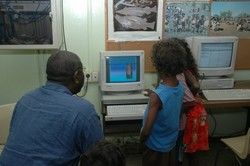
Capacity of School Networks
QSITE conducted a study in 2005 which led to a position paper on the the capacity of school networks to meet new curriculum agendas and to enable to students to work digitally in schools.
QSITE Capacity of School Networks Position Paper
 QSITE in conjunction with the Australian Computer Society (ACS) and James Cook University, Cairns conducted a study in 2005 which led to a position paper on the the capacity of school networks to meet new curriculum agendas and to enable to students to work digitally in schools (and homes and workplaces and other institutions), in the future.
QSITE in conjunction with the Australian Computer Society (ACS) and James Cook University, Cairns conducted a study in 2005 which led to a position paper on the the capacity of school networks to meet new curriculum agendas and to enable to students to work digitally in schools (and homes and workplaces and other institutions), in the future.
The school authorities in Queensland have renewed vigour in shaping the quality of schools’ ICT facilities. New curriculum reforms, assessment practices, and pedagogical reform have implications for how students, teachers and others in schools will use ICTs to develop products and undertake processes. Further the changing nature of schools, ETRF agendas and general school reform alter where students learn and how they learn. The design of school networks and the capacity they have, needs to meet these agendas and perhaps lead them. QSITE members will be the people who shape the agendas and so this project is strategically important for QSITE and personally important to every member of the organisation.
>> Download Capacity of School Networks Position Paper
At the QSITE Conference, the initial data was reported. The data shows that although school networks are more robust, extensive in a school setting and increasingly manageable within the limited resources available to schools, the quality of services available to users is not sufficient to deliver quality ICT learning environments to students and their teachers. Further decision making in school is determined on management issues, not curriculum and pedagogical issues. A brave conclusion – we have data to back up such conclusions. We now need to identify the issues QSITE can debate, so we promote network designs that will match the future needs of learners.
The project involved collecting data from all systems and types of schools where QSITE membership reaches. The data was collected by survey – the instrument involves about 40 minutes to complete it.
